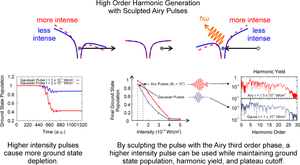High-order harmonic generation (HHG) has become an indispensable process for generating attosecond pulse trains and single attosecond pulses used in the observation of nuclear and electronic motion. As such, improved control of the HHG process is desirable, and one such possibility for this control is through the use of structured laser pulses. We present numerical results from solving the one-dimensional time-dependent Schrödinger equation for HHG from hydrogen using Airy and Gaussian pulses that differ only in their spectral phase. Airy pulses have identical power spectra to Gaussian pulses, but different spectral phases and temporal envelopes. We show that the use of Airy pulses results in less ground state depletion compared to the Gaussian pulse, while maintaining harmonic yield and cutoff. Our results demonstrate that Airy pulses with higher intensity can produce similar HHG spectra to lower intensity Gaussian pulses without depleting the ground state. The different temporal envelopes of the Gaussian and Airy pulses lead to changes in the dynamics of the HHG process, altering the time-dependence of the ground state population and the emission times of the high harmonics.
High-order harmonic generation (HHG) using an Airy pulse with a third order spectral phase results in less ground state depletion, but similar harmonic yield, compared to a Gaussian pulse. Top – schematic depiction of the 3-step HHG process for different intensity pulses. Bottom left – time-dependent ground state populations for Gaussian pulses showing that a more intense pulse causes more ground state depletion. Bottom middle – final ground state populations for Airy and Gaussian pulses as a function of intensity showing that Airy pulses result in less ground state depletion for a given intensity. Bottom right – HHG spectra for a more intense Airy pulse and a less intense Gaussian pulse exhibit similar shapes, magnitudes, and plateau cutoff values



